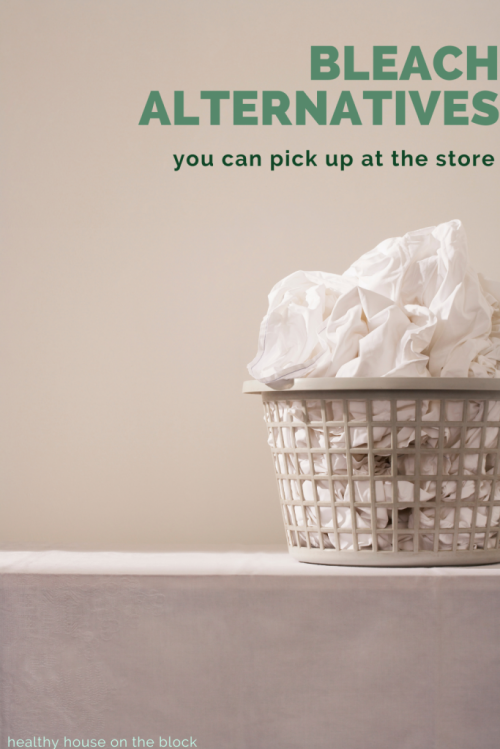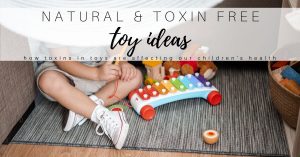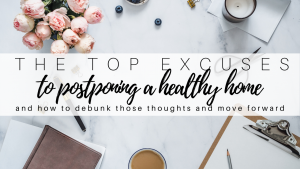
I can happily say it’s been years since we’ve had any form of bleach in our home….and while I thought I would miss it when it came to laundry, I’ve found so many bleach alternative options that I didn’t even notice that jug of household bleach missing.
Bleach has been used for years and years, and if you’re like me, growing up in the nineties, bleach was a common household product. It was used to clean inside and outside as well as keep laundry white. And that smell — there’s no mistaking the strong odor of chlorine bleach.
It’s another example of how we can derail healthy house practices if we just fall into the habits we grew up with or the methods and products that our parents or grandparents used. The beauty of the world we live in is that we learn more and more about the products that are being used around us on a regular basis and we then have the opportunity to change and make a better choice.
Bleach is one of those big ones. I think it’s safe to say that some of us feel like a surface won’t be truly cleaned or sanitized if we don’t use bleach. There’s this feeling that anything less than chlorine bleach will leave viruses and bacteria behind.
The truth is there are so many bleach alternative options that will not only whiten and clean, but also disinfect. But I should also mention that if you disinfect surfaces so thoroughly, you can actually leave us at a disadvantage. It’s actually important to come in contact with a healthy variety of bacteria so that our bodies don’t become unaccustomed to them.
A completely sanitized space is especially harmful to kids — creating problems like asthma and allergies as they get older. This is why I love bleach alternative options (besides them being toxin free and safe to use). They don’t over sanitize your space and leave you with a sterile environment.

THE TOXINS IN EVERYDAY BLEACH
Chlorine: This is one of the most well known chemicals for disinfection. Chlorine is not only used in our drinking water to disinfect it from bacteria, but we also use it in various cleaning applications and swimming pools. Chlorine generally has many short term health effects associated with it including irritation to skin, eyes and airways. However, a study found a correlation between chlorine use and damage to the liver and lungs long term. (STUDY)
Fragrance: A lot of household bleach comes with added fragrance so that your house or clothes don’t smell like the local YMCA. But the fragrance added to cover up the smell of chlorine contains phthalates that disrupt your hormones and harm your reproductive system and your thyroid.
Sodium Hypochlorite: Many standard household bleach contains sodium hypochlorite, a chemical that not only kills bacteria, but also whitens and removes odor. Because this substance is extremely corrosive, it can cause skin irritation, airway discomfort and damage, especially in children (SOURCE). This is an extremely reactive and caustic
Byproducts: Chlorine can react with organic materials or other chemicals to produce byproducts. Byproducts produced from chlorine bleach such as chloramines and chloroform are known carcinogens to the body and can also trigger chronic health ailments like asthma and allergies. (SOURCE)

EXPOSURE TO BLEACH
In general, there are three ways that we come in contact with toxins — they are the toxins that go in you (ingest), the toxins that go on you (absorption) and the toxins that are around you (inhalation). Bleach generally is not ingested (however chlorine does fall in this category through our drinking water). But we do come in contact with bleach with the other two avenues:
Absorption: Bleach that is used on clothing, sheets or towels ends up being absorbed into our skin as the fabric sits on top of us. The skin is our body’s largest surface area and organ and it’s constantly absorbing what is in contact with it. Bleach becomes embedded into the fibers of our fabrics and allows our skin to absorb those chemicals and toxins. Once absorbed they make their way to our bloodstream and travel throughout our body.
Inhalation: When you’re using bleach as a cleaning agent, a gas is produced that allows us to inhale the toxins from the bleach. Bleach often has a very strong odor and you know immediately that you’re inhaling the toxic gas from the cleaning solution you’re using. When we inhale toxic chemicals they can not only damage our airways, but if the toxin is in vapor droplets, they can travel deep into our lung tissue and become embedded there.

HEALTHY BLEACH ALTERNATIVE OPTIONS TO BUY

Nellie’s All Natural Oxygen Brightener: The ingredients list lists sodium carbonate at the top, which is essentially hydrogen peroxide, which is considered safe for use, but can cause skin irritation if used incorrectly. This powder can be used in the laundry and as a spot remover for carpets and fabrics.

Seventh Generation Chlorine Free Bleach: This is probably the most comparable replacement for a jug of household bleach. Essentially just water and hydrogen peroxide, it’s an extremely safe product for both humans and the environment. It’s also Whole Foods Market Eco Scale Rated based on the chemical composition and disclosure of ingredients.

BioKleen Oxygen Bleach Plus: Because this oxygen bleach doesn’t use chlorine, you can use it safely with colors. It contains no preservatives or fragrance added, making it a safe, toxin free version of powder bleach. Instead, it uses grapefruit seed extract and natural bleach alternatives. Great for mixing with water and applying to upholstery, carpet, grout and more.

Grab Green Natural Bleach Alternative Pods: Um, laundry has never been so easy. These are chlorine free and fragrance free and you can simply toss them into the wash to remove stains and brighten whites. Grab Green is known for full ingredient disclosure and making great biodegradable products – and this one is no exception.

Branch Basics Oxygen Boost: A super concentrated powder that is biodegradable and plant and mineral based. It consists of only sodium percarbonate and sodium bicarbonate, which can be used in laundry, on pots and pans and other cleaning applications like tile and grout.

HEALTHY BLEACH ALTERNATIVE OPTIONS TO DIY
Food Grade Hydrogen Peroxide: Not only does it whiten the whites, it also disinfects surfaces and neutralizes odors. Just make sure your bottle fizzes when you open it (otherwise it might be old and really won’t work). Hydrogen peroxide is an amazing bleach alternative, but needs to be kept in that dark bottle it comes in otherwise it loses its cleaning ability.
Be sure to use 3% hydrogen peroxide and always do a patch test on fabrics first. Here are some great applications for hydrogen peroxide:
- Add 1 part hydrogen peroxide and 2 parts water to an empty washing machine drum before you add your laundry for a laundry booster
- Add 1 cup hydrogen peroxide to your bleach dispenser in your washing machine
- Spray a small amount on laundry stains. Allow it to soak into the fabric for 10 minutes before washing
Sunlight: I mean it’s free and it’s the original way to whiten whites. The sun’s ultraviolet rays work to disinfect fabrics as well as brighten them and remove stains. It can also fade your colored clothes, so you’ll want to pick and choose what you leave out in the sun.
Vinegar: Vinegar not only helps disinfect (it’s about 80% effective against viruses and mold), but it also helps to brighten your laundry as a bleach alternative. Vinegar also helps remove soap residue, making your fabrics feel a little softer. Just add ½ cup to your washing machine with your laundry
Baking Soda: Sometimes whites get grey and dingey from hard water (calcium deposits in the water). Baking soda is excellent for eliminating hard water residue from surfaces and clothing, which brings them back to their original white color. Simply add baking soda to your wash just as you would a powder laundry booster – anywhere from ½ cup to 1 cup depending on the size of your load.
Lemon: Lemon not only brightens your clothes, but it also helps to remove stains. It’s 100% natural and a great way to get your laundry smelling fresh without any added fragrance. You can slice up 1-2 lemons and fill a basin with hot water. Simply add your garments to the water and let it soak for a few hours before washing.

Going toxin free luckily doesn’t mean you have to let your laundry and sparkling white grout and tile go. There’s always a good bleach alternative option that can help keep whites bright and disinfect surfaces in your home.

Share this:
- Click to share on Facebook (Opens in new window) Facebook
- Click to share on LinkedIn (Opens in new window) LinkedIn
- Click to share on Reddit (Opens in new window) Reddit
- Click to share on Pinterest (Opens in new window) Pinterest
- Click to print (Opens in new window) Print
- Click to share on X (Opens in new window) X



